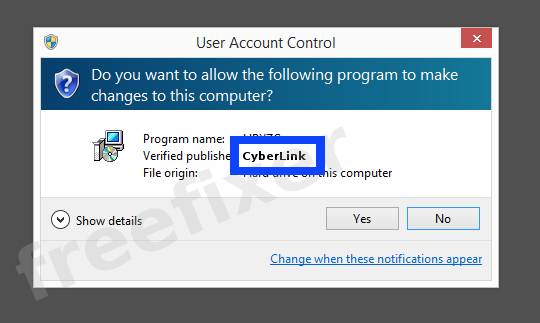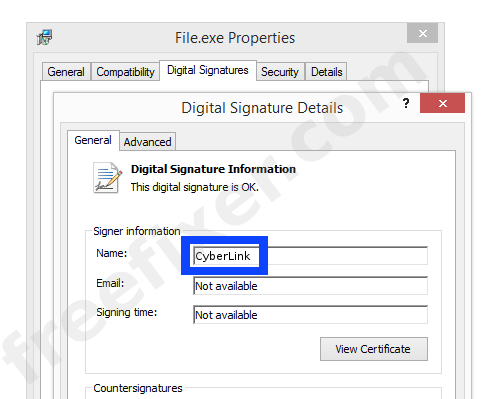CyberLink - 0.066% Detection Rate *
Did you just stumble upon a file that is digitally signed by CyberLink? If so, please read on.
You will probably see CyberLink when clicking to run the file. The publisher name shows up as the "Verified publisher" in the UAC dialog as the screenshot shows:

You can view the additional details from the CyberLink digital signature with the following procedure:
- Open up Windows Explorer and locate the CyberLink file
- Right-click the file and select Properties
- Click the Digital Signatures tab
- Click the View Certificate button
Here's a screenshot of a file digitally signed by CyberLink:

As you can see in the screenshot above, the Windows OS states that "This digital signature is OK". This means that the file has been published by CyberLink and that no one has tampered with the file.
If you click the View Certificate button shown in the screenshot above, you can view all the details of the certificate, such as when it was issued, who issued the certificate, how long it is valid, and so on. You can also see the address for CyberLink, such as the street name, city and country.
VeriSign Class 3 Code Signing 2004 CA and VeriSign Class 3 Code Signing 2010 CA has issued the CyberLink certificates. You can also see the details of the issuer by clicking the View Certificate button shown in the screencap above.
CyberLink Files
These are the CyberLink files I've collected, thanks to the FreeFixer users.
The FreeFixer tool treats files from CyberLink as trusted, which means that the CyberLink files will appear with a green background and that there is no removal checkbox for the file. However, as you can see in the scan results below, a few of the anti-virus scanners detects the CyberLink file(s). I'm pretty sure those detections are incorrect and that the files are safe. It's unlikely that CyberLink would ship a malware file.
| Detection Ratio | File Name |
|---|---|
| 1/53 | CLMLSvc.exe |
| 1/57 | CLMLSvc.exe |
| 1/48 | PDVD8Serv.exe |
| 1/57 | SecurityBrowser.exe |
| 1/55 | SecurityBrowser.exe |
| 4/38 | brs.exe |
| 1/57 | PowerDVDCox10.exe |
| 1/57 | PDVD11Serv.exe |
| 0/46 | YCMMirage.exe |
| 0/45 | 000.fcl |
| 0/42 | CLQTKernelClient32.exe |
| 0/51 | RICHVI~1.EXE |
| 0/48 | PDVD10Serv.exe |
| 0/47 | YCMMirage.exe |
| 0/47 | VirtualDrive.exe |
| 0/50 | MUIStartMenu.exe |
| 0/47 | MUIStartMenu.exe |
| 0/50 | richvideo.exe |
Scanner and Detection Names
Here's the detection names for the CyberLink files. I have grouped the detection names by each scanner engine. Thanks to VirusTotal for the scan results.
As mentioned above, I think these detections are incorrect since it is very unlikely that CyberLink would ship a malware file.
| Scanner | Detection Names |
|---|---|
| Antiy-AVL | Worm[P2P]/Win32.Palevo |
| Bkav | HW32.Laneul.nqym, W32.HfsAdware.D159, W32.HfsAdware.D4FF |
| CAT-QuickHeal | (Suspicious) - DNAScan |
| Rising | PE:Trojan.Win32.Generic.1252F2F8!307426040, PE:Malware.Loader!6.17A6 |
| SecureWeb-Gateway | Virus.Win32.FileInfector.gen (suspicious) |
| Sunbelt | VIPRE.Suspicious |
| eSafe | Suspicious File |
* How the Detection Percentage is Calculated
The detection percentage is based on that I have gathered 16607 scan results for the CyberLink files. 11 of these scan results came up with some sort of detection. If you like, you can review the full details of the scan reports by examining the files listed above.
Analysis Details
The analysis is done on certificates with the following serial numbers:
- 37d3740fb04db7fa54dfdf358bef6d5f
- 79e299006f7ae25e062b1a7a067fc548
- 1d226108cbb0eb7b504697bdfec66a8b